ETFS – WHY SO POPULAR?
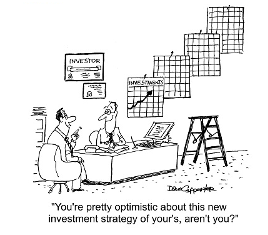
Some background:
Exchange Traded Funds or ETFs are relatively young investment structures (“The first ETF was introduced in Canada in 1990, via a product which tracked the largest 35 companies available on the Toronto Stock Exchange”[1]). So, we will firstly describe the structure of Unlisted Managed Funds, then move onto ETFs.
An Unlisted Managed Fund is essentially a UNIT TRUST that is established to pool investor’s cash with other investors’ cash, which is then invested into a specific asset class, (eg. Australian Shares / Equities) or investment strategy, (eg. Hedge Fund or Multi Asset Fund) by the FUND MANAGER.
The investor is issued a number of units in the
UNIT TRUST depending on their cash investment. Hence if the unit price of the fund is
$2.50
per unit and the investor invests
$1,000,
then they will be issued 400 units in the Unlisted Managed Fund (UNIT TRUST).
The unit price is a function of number of units on issue divided by the value of the underlying assets less costs and liabilities of the UNIT TRUST. The unit price hence reflects the NAV, (Net Asset Value) divided by the number of units that that have been issued.
The unit price of the UNIT TRUST will rise or fall depending on:
- The change in price of the underlying assets. For example, if the FUND holds Australian Shares and the prices in aggregate of the shares held appreciates then the unit price, all things being equal, will also rise. The opposite is also true.
- The accumulation of cash from investments. For example, the underlying assets held by the fund may generate income, (Cash will generate Interest, Bonds generate Coupons and Shares generate Dividends) and if the manager sells part of the portfolio and generates a capital gain, this gain forms part of the FUND’S income also.
- The payment of DISTRIBUTIONS, (FUND income is called a DISTRIBUTION and can include interest, coupons, dividends as well as realised capital gains). A UNIT TRUST must pay out FUND income each financial year, the unit price of the UNIT TRUST will generally fall by the size of the DISTRIBUTION paid –
simplified example follows:
$1000 Fund Portfolio Value and 100 units on issue, hence unit price is $10 ($1,000 / 100 units).
$1,000 Portfolio is invested and generates 5% income over the year ($50 – hence the portfolio assuming no change in asset prices is now $1,050), hence the unit price is now $10.50 ($1,050 / 100 units).
The manager pays out the income to the investors ($50 or $0.50 per unit – reducing the portfolio value to $1,000). Hence the new unit price is
$10 ($1,000 / 100 units).
Unlisted Managed Funds are OPEN ENDED, which means that new units can be issued to investors if they are new investors to the fund or are existing investors wanting to invest more. The NEW CASH is used to purchase more assets in the UNIT TRUST. If the investor wants to redeem some or all of their investment in the UNIT TRUST, the manager / administrator of the FUND will cancel the investor’s units and give the investor CASH, (the amount returned to the investor being a function of number of units held, the unit price on the date of the redemption and the buy/sell spread[2]).
Redemptions are generally processed within a week, (though some funds are less liquid and take longer to settle redemptions) and are funded by the manager / administrator of the FUND either by the sale of assets held by the fund or via the FUND’s cash holdings.
Unlisted Managed Funds can invest either PASSIVELY and hence track a particular Index or Benchmark or be ACTIVE, where the manager aims to generate a return above the Index or Benchmark or may have another objective, such as a return above CPI with a specific level of RISK etc.
Example of a PASSIVE / INDEX Unlisted Managed Fund is the Vanguard Australian Shares Index Fund which tracks the return of the ASX 300 as illustrated below, [May 2009[3] to Dec 2021]:

Example of an ACTIVE Unlisted Managed Fund is the Pengana Australian Equities Fund which aims to enhance and preserve investor wealth over a 5 year period, [May 2009 to Dec 2021]:
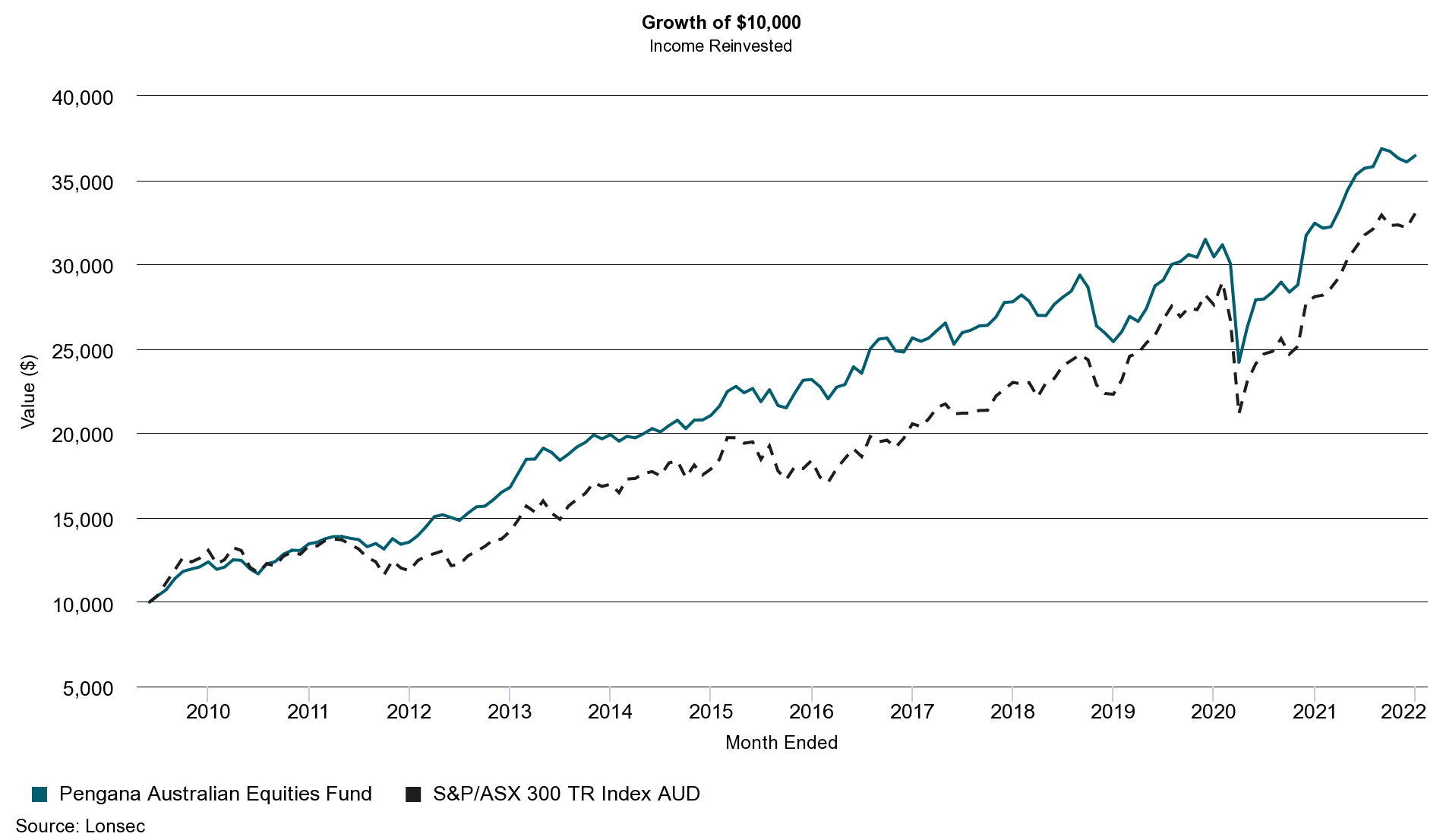
Exchange Traded Funds or ETFs are Investment FUNDS, (also structured via a UNIT TRUST) that are traded on a stock exchange (for example the ASX or Australian Stock Exchange) and like UNLISTED FUNDS (which we prefer to use) give investors access to a basket of securities or assets within one structure.
Each ETF ‘generally’ looks to replicate the returns of a specific index/benchmark or industry. For example, the Vanguard Australian Shares Index ETF (VAS.ASX) replicates the return of the ASX 300 as illustrated below [May 2009 to Dec 2021]:
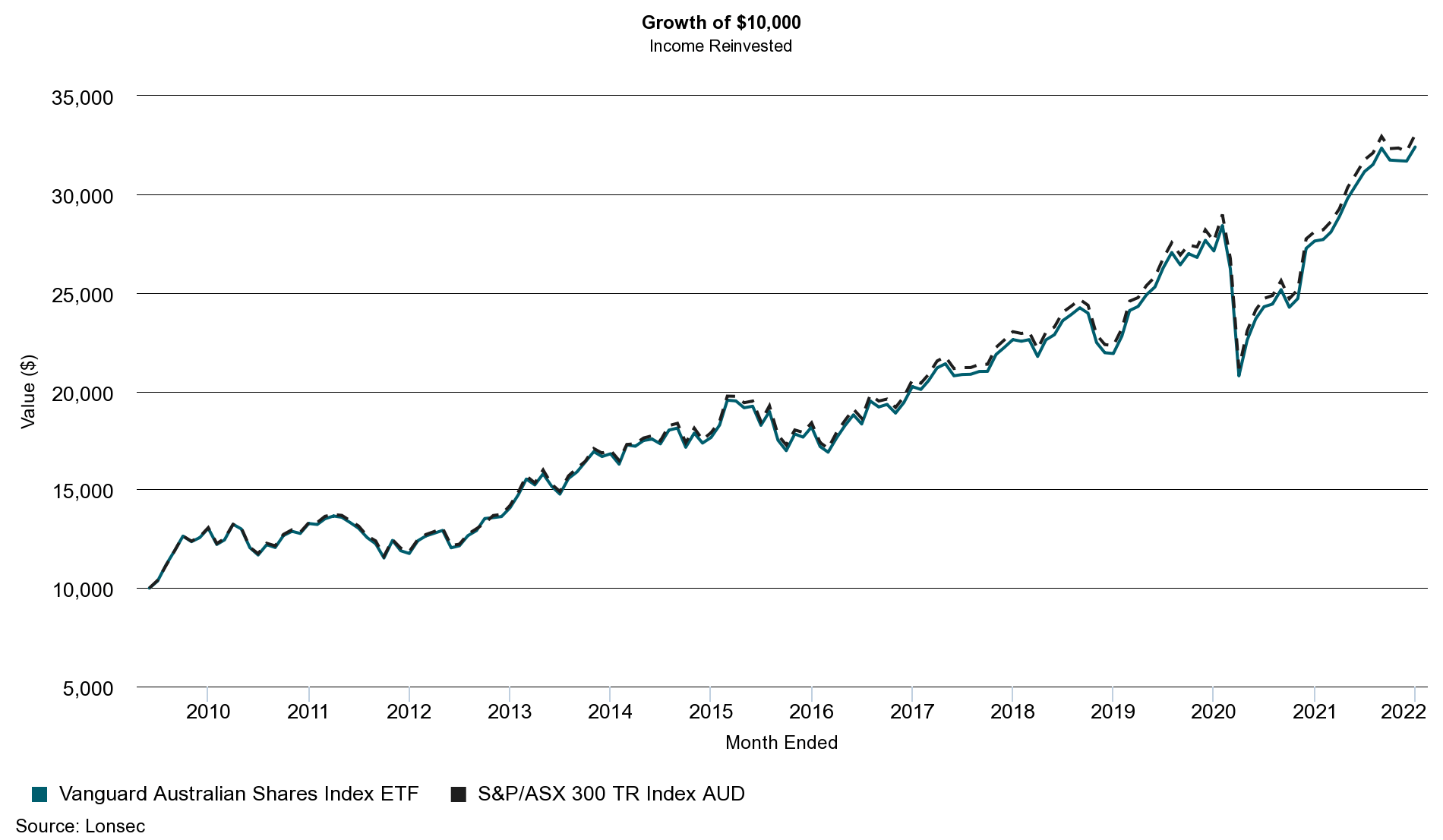
There are many ETFs available to investors, a sample is provided below, which provide investors with access to a range of different types of assets, not just equities:
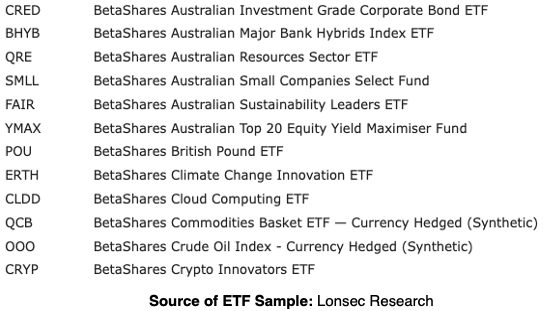
You trade and settle ETFs like ordinary shares, however unlike Closed Ended Investment structures (see paragraph below), ETFs trade at a unit price close to the net asset value of the underlying portfolio – NAV, (Net Asset Value - represents the value of the underlying asset or holdings net after all fees, costs and liabilities have been deducted) – this occurs thanks to ETF Creation and Redemption, which aims to keep the unit price of the EFT (which again is traded) close to the NAV.
Note again for Unlisted Managed Funds the unit price reflects the NAV.
Close Ended Investments such as Listed Investment Companies, (LICs) or Listed Investment Trusts, neither issue new shares or cancel existing shares. Instead, they issue a fixed number of shares in an IPO, (Initial Public Offering) and the share price is determined by the trading of shares on the stockmarket. Hence there can be a divergence between the LIC’s share price and the NAV. The share price may trade below NAV, (at a discount) or above NAV, (at a premium). Obviously, preference is not to purchase LIC shares at a price above what the underlying assets (NAV) are worth.
The process of how ETF prices trade close to NAV is illustrated by the following chart [please visit - https://www.betashares.com.au/insights/etf_creation/ for more detail]:
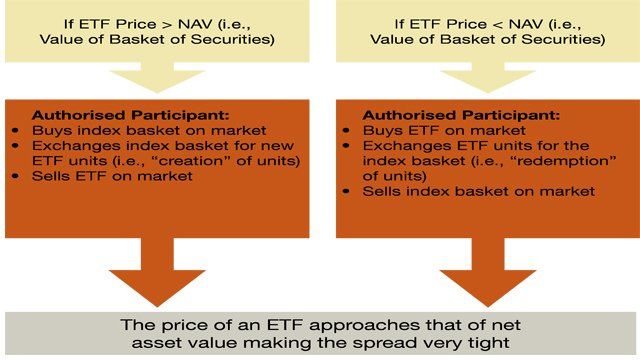
SO WHY ARE EXCHANGE TRADED FUNDS OR ETFS SO POPULAR?
Some reasons suggested for their popularity include:
- low cost
- easy to invest in
- diversification and access to a range of assets.
We also believe that ‘good marketing’ is another reason for the popularity of ETFs.
Let’s discuss the 3 reasons mentioned above why ETFs are popular:
Low Cost
While ETFs can offer investors a low-cost investment vehicle, the costs of investing in ETFs can be higher than investors think, when transaction (ie brokerage) fees are taken into account.
The difference in management fees may also not make much difference, for example the management fee for the Vanguard Australian Shares Index Fund is 0.16%pa vs 0.10%pa for the Australian Shares Index ETF (VAS.ASX). As you can see from the table below, both Vanguard Funds underperformed the INDEX and the ETF version generated over 10 years 0.03%pa better returns, (likely off-set by brokerage fees) compared to the unlisted managed Fund version:

In addition, not all ETFs offer low management fees. The Betashares Cloud Computing ETF (CLDD: ASX) management fee is 0.67%pa for example. It is also important to note that FEES, while important, are not the main determinant of PERFORMANCE, asset allocation and the prevailing investment environment has a larger impact on comparative returns than FEES as illustrated below for period May 2009 to Dec 2021:
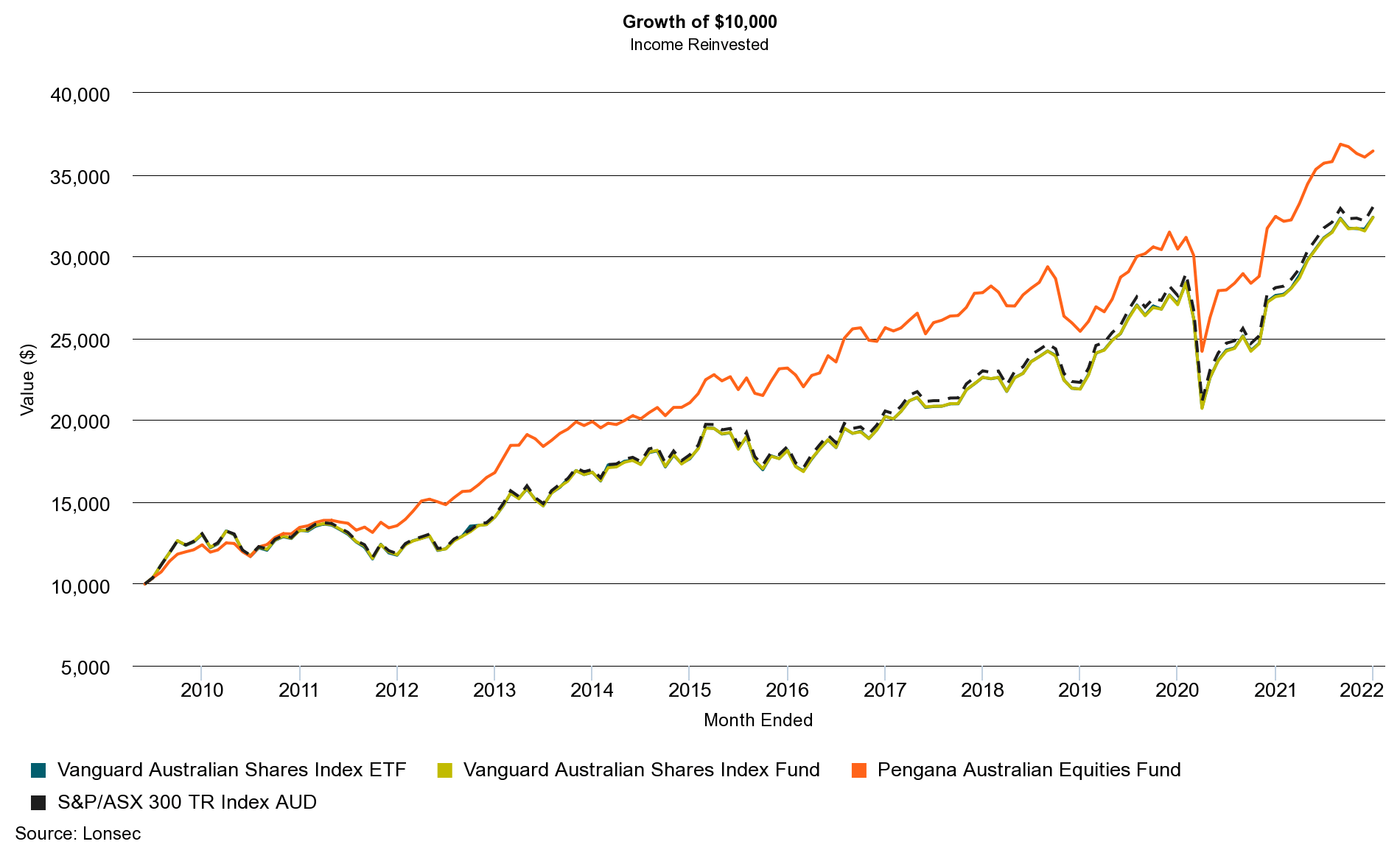
The best performing FUND (above) being the ACTIVE FUND with a higher management fee 1.025%pa, plus a performance fee of 10.25% if certain return criteria is achieved.
If FEES were the main determinant of returns, the two Vanguard (ETF and Unlisted Fund) Funds would have outperformed the Active Fund.
Easy to invest in
While ETFs are listed, this does not automatically mean that they are easy to invest in. The investor needs to set up a trading account with either a full service or discount share brokerage service. Noting that many Unlisted Managed Funds are available via share brokerage services as MFunds [visit https://www.asx.com.au/mfund/about-mfund.htm for more information]. Unlisted Managed Funds are typically invested via WRAP services which offer efficient online execution services as well as consolidated performance reporting and tax reports. Though for these features offered by WRAP services, an administration fee is charged by the WRAP service provider, (no such thing as a free lunch).
Diversified and Access to a range of assets
While ETFs can offer diversification, (as do
Unlisted Managed Funds) how real the diversification is depends on what ETFs you invest in as illustrated below by the two BetaShares ETFs which exhibit correlated return profiles[4] [Feb 2021 to Dec 2021]:
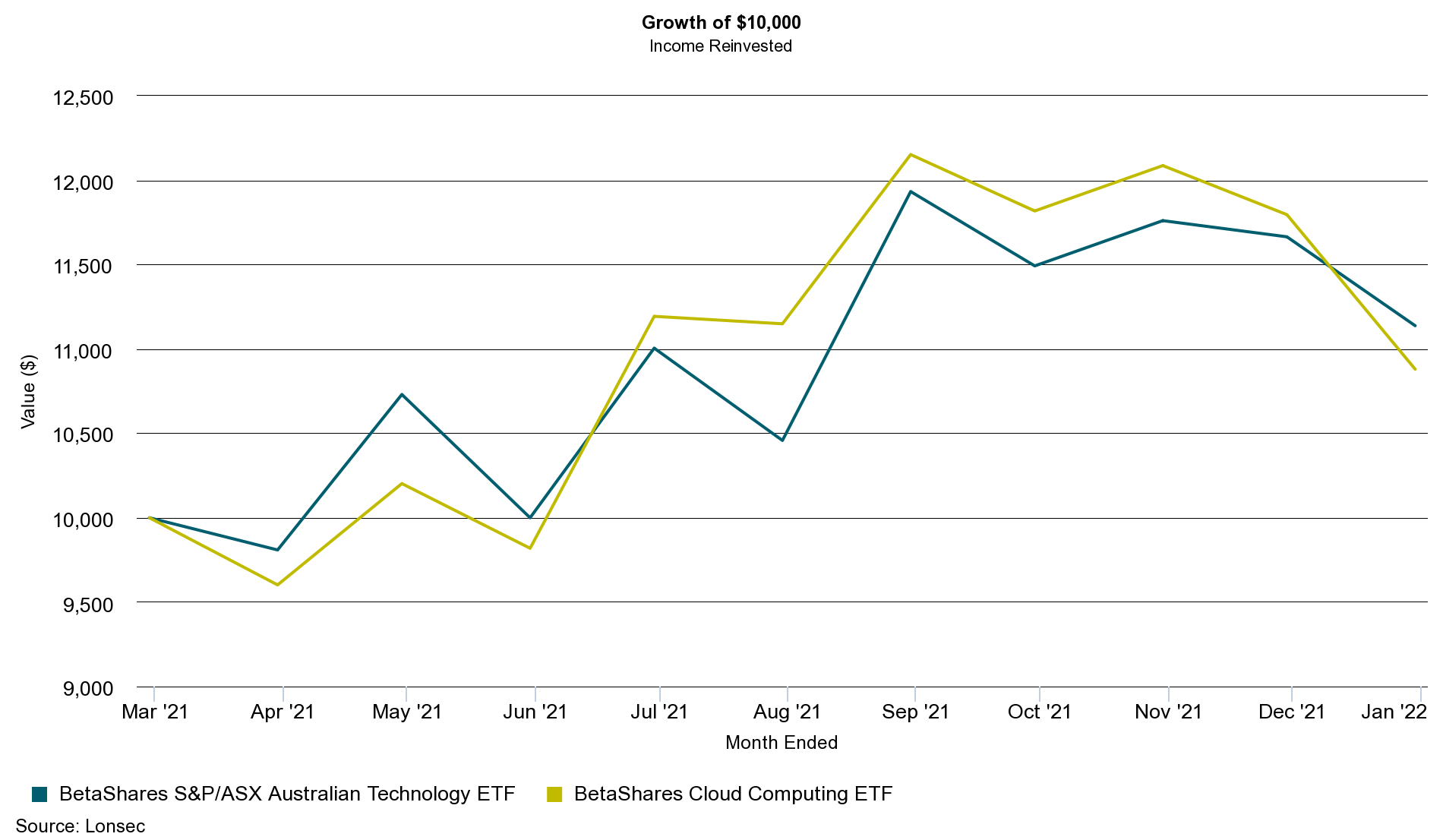
Summing Up:
ETFs are essentially a vehicle to access investments. As they are a ‘structure’ only, your investment success will not be the result of using an ETF over say an Unlisted Managed Fund or the other way round. Instead, investment success or failure will depend on which asset classes and investment strategies you invest in and the prevailing investment environment and how the investment conditions impact on your asset allocation’s performance.
If you want confirmation of why asset allocation is more important than structure selection, please refer to the following which shows 3 BetaShares ETFs for the period Aug 2015 to Dec 2021:

All three ETF investment strategies are SHORTING[5] their relevant benchmark/index, hence only make money when the relevant benchmark/index is falling. While they may have value if the investor can get the timing right, ie invest just before the next major (GFC like) CORRECTION, as a long-term investment they are a DUD – for example $10,000 invested Aug 2015 in the US Equities Strong Bear Hedge Fund (ETF) would be worth $600 @ 31/12/2021 or -94% over the period.
A touch of scepticism is healthy to have when making a decision. As we hope we have illustrated, it is important to ‘question’, before ‘committing’ to any investment decision or the use of a specific investment vehicle.

“Success takes an investment in time, dedication and sacrifice. This is true education. It is a process.”
—Robert Kiyosaki
[1] https://www.betashares.com.au/education-investors/exchange-traded-funds-comprehensive-guide/
[2] Unlisted managed funds may charge investors an estimate of the transaction costs that the fund will incur to buy or sell its underlying assets. This buy/sell spread is incorporated into the price paid to purchase or sell units and the amount of the spread accrues to the fund and reflects the difference between the buy and sell unit prices of the fund. It reflects the transaction costs a fund incurs when buying and selling assets such as brokerage, custody costs, government taxes and bank charges.
[3] Inception date for VAS (Vanguard Australian Shares Index) ETF.
[4] Diversification aims to include a range of un-correlated assets / strategies in a portfolio so that they do not fall at the same time.
[5] Shorting is the process of borrowing stock in anticipation of the stock price falling, selling the borrowed stock with the aim of buying back the stock and returning to the stock lender and making a profit by the stock falling in price. This strategy over an index/benchmark does not work well during a BULL (rising) MARKET.
While much care has been taken in compiling this BLOG FM Financial Solutions and its representative take no responsibility for its accuracy. This information is not designed to take the place of professional advice. Please seek professional advice before making financial or other decisions.
